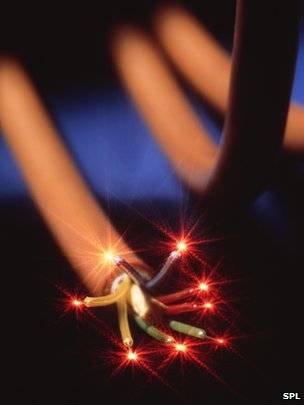Mebbe dey took off when the other guy wasn't lookin'...

Deutsche Telekom claims record data transfer record
6 March 2012 - Deutsche Telekom says the innovation will allow it to upgrade its networks without digging up cables

Deutsche Telekom claims record data transfer record
6 March 2012 - Deutsche Telekom says the innovation will allow it to upgrade its networks without digging up cables
Deutsche Telekom says it has set a new data transfer speed record over a long distance and outside a laboratory. The German firm says it achieved a usable bit rate of 400Gbps (gigabits per second) over a single channel of its fibre optic network. That is more than double the 186Gbps record set by researchers in the US and Canada last year. The company says it now plans to roll out the technology to ensure users can enjoy an "unclogged" service. The experiment was carried out by sending data along the company's network between Berlin and Hanover and back again - a total distance of 734km (456 miles).
The experiment delivered a maximum 512Gbps down each channel, of which 400Gbps was usable data - the spare capacity is used to provide error correction. That is the equivalent of being able to transmit 77 music CDs simultaneously within a second. Each optical fibre is thinner than a human hair but can carry a total of 48 channels - making the total potential throughput up to 24.6Tbps (terabits per second) - or the equivalent of 3,696 CDs per second.
Software upgrade
The firm says the feat was achieved by working with Alcatel Lucent to create new technologies which were installed in its terminal stations at either end of the fibre. Much of the speed gain was delivered through improvements to the software used for forward error correction - a technique that encodes and then decodes the data, allowing a limited amount of corrupted bits to be corrected without the need for the information to be resent.
"You can imagine it as squeezing and tilting the entire set-up around to get more capacity out," Deutsche Telekom's T-Labs manager Heinrich Arnold told the BBC. "It means improvements can be carried out without digging up the existing fibre, without massive hardware replacement - that's actually the charm of the thing. "Whenever we can do something where the biggest part of the infrastructure remains untouched, it means great progress becomes possible." Rather than faster broadband speeds, the firm says the key benefit for home users will be be that they notice an "available, open network" that appears to work more efficiently than at present.
BBC News - Deutsche Telekom claims record data transfer record


